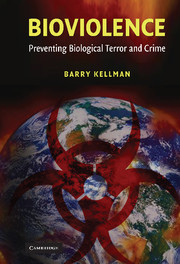Book contents
- Frontmatter
- Contents
- Prologue
- Foreword, by Ronald K. Noble, Interpol Secretary General
- Acknowledgments
- Introduction
- PART I THE BIOVIOLENCE CONDITION AND HOW IT CAME TO BE
- PART II THE GLOBAL STRATEGY FOR PREVENTING BIOVIOLENCE
- 4 Strategic Foundations
- 5 Complication: What Law Enforcers Should Stop
- 6 Improving Resistance through Science
- 7 Public Health Preparedness
- 8 International Nonproliferation
- 9 The Challenge of Global Governance
- Conclusion
- Notes
- Bibliography
- Index
5 - Complication: What Law Enforcers Should Stop
Published online by Cambridge University Press: 27 July 2009
- Frontmatter
- Contents
- Prologue
- Foreword, by Ronald K. Noble, Interpol Secretary General
- Acknowledgments
- Introduction
- PART I THE BIOVIOLENCE CONDITION AND HOW IT CAME TO BE
- PART II THE GLOBAL STRATEGY FOR PREVENTING BIOVIOLENCE
- 4 Strategic Foundations
- 5 Complication: What Law Enforcers Should Stop
- 6 Improving Resistance through Science
- 7 Public Health Preparedness
- 8 International Nonproliferation
- 9 The Challenge of Global Governance
- Conclusion
- Notes
- Bibliography
- Index
Summary
Law enforcement's potent crime-fighting capabilities should be committed worldwide to detect and interdict bioviolence preparations. In most nations, however, police and other law enforcers are inadequately authorized and woefully lack information that would enable effective action. Recently, the United Nations Security Council and Interpol have each taken impressive strides to improve law enforcement authority and capacity, but the problem is far too vast for these measures to fill the void. Much more is needed.
A recent incident highlights this need. In June 2006, The Guardian newspaper reported that it easily obtained some smallpox DNA through the mail. It used an invented company name, a mobile phone number, a free e-mail address, and a house in north London to receive a plastic bag containing a small vial holding a white gel – the DNA. The source, VH Bio Ltd., did not know that the supplied material is part of the smallpox genome. VH Bio's chairman said that it is impossible to screen orders for short genetic sequences; in any event, no laws require background checks on potential customers. The Guardian reported that five of twelve gene synthesis companies that it surveyed in North America and Europe always screen their orders for suspect sequences; three said they never do. Fortunately, this DNA sample was only a tiny fraction of a smallpox genome. There is scant risk that someone could order consecutive links and patch them together to make a whole virus.
- Type
- Chapter
- Information
- BioviolencePreventing Biological Terror and Crime, pp. 101 - 131Publisher: Cambridge University PressPrint publication year: 2007



